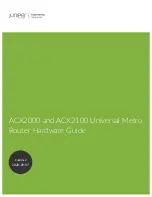
Chapter 2:
Cabling Requirements
Page 2-2
BRIM-E100 User’s Guide
Jitter
Intersymbol interference and reflections cause jitter in the bit cell timing,
resulting in data errors. A 100BASE-TX link must not generate more than
1.4 nanoseconds (ns) of jitter. If the cable meets the impedance
requirements for a 100BASE-TX link, jitter should not be a concern.
Crosstalk
Crosstalk is caused by signal coupling between the different cable pairs
contained within a multi-pair cable bundle. 100BASE-TX transceivers are
designed so that the user does not need to be concerned about cable
crosstalk, provided the cable meets all other requirements.
Noise
Noise is caused by either crosstalk or externally induced impulses.
Impulse noise may cause data errors if the impulses occur at very specific
times during data transmission. Generally, the user need not be concerned
about noise. If noise-related data errors are suspected, it may be necessary
to either reroute the cable or eliminate the source of the impulse noise.
UTP Propagation Delay
Propagation delay is the amount of time it takes data to travel from the
sending device to the receiving device. Total propagation delay allowed
for the network is 256 bit times. 256 bit times is equivalent to 2.56
microseconds (
µ
s) at 100 Mbps operation or to 25.6
µ
s at 10 Mbps
operation. If the total propagation delay between any two nodes on the
network exceeds 256 bit times, then further segmentation of the network
through the use of bridges or other devices is required.
Temperature
The attenuation of PVC insulated cable varies significantly with
temperature. At temperatures greater than 40
°
C (104
°
F), Cabletron
Systems recommends the use of plenum-rated cables to ensure that cable
attenuation remains within specification.
book Page 2 Friday, April 19, 1996 9:53 AM
















































